I, Daniel Blake Review
The Pursuit Of Happyiness
Released : October 21st 2016
Certificate : 15
Director : Ken Loach
Cast : Dave Johns, Hayley Squires, Natalie Ann Jamieson, Micky McGregor
Plot : Daniel Blake (Johns) struggles with the complexities and harshness of the welfare system after a major heart attack. Seemingly unable to qualify for benefits, alike single mother (Squires), together they face poverty.
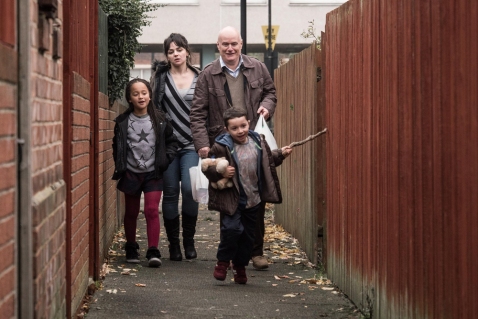 Ken Loach, the quietly famous British director famous for the classic Kes, reunites with frequent collaborating writer Paul Laverty. Together their most famous work includes The Wind that Shakes the Barley, and more recently The Angles’ Share, and now I, Daniel Blake. Ken Loach in his most famous for his films about the everyday British citizen, within different stories. Often Loach’s film have a humorous edge but ultimately poetic sadness to them, the style which has made him famous. While his other films, alike with Laverty has a slight quirky edge to the story that accompanies the social commentary aspects of the film, I, Daniel Blake doesn’t contain such uniqueness or quirky edge. It is a straightforward social commentary about the poor suffering with the benefit system of Britain, told through a humours melodramatic tone and subtly directing and writing.
Ken Loach, the quietly famous British director famous for the classic Kes, reunites with frequent collaborating writer Paul Laverty. Together their most famous work includes The Wind that Shakes the Barley, and more recently The Angles’ Share, and now I, Daniel Blake. Ken Loach in his most famous for his films about the everyday British citizen, within different stories. Often Loach’s film have a humorous edge but ultimately poetic sadness to them, the style which has made him famous. While his other films, alike with Laverty has a slight quirky edge to the story that accompanies the social commentary aspects of the film, I, Daniel Blake doesn’t contain such uniqueness or quirky edge. It is a straightforward social commentary about the poor suffering with the benefit system of Britain, told through a humours melodramatic tone and subtly directing and writing.
The first issue with I, Daniel Blake (as with the rest of Loach’s films) is that they don’t exactly enthral the average cinema goer. Loach makes slow paced subtle films that a rooted in clarity of character and dry directing. In other words, the films stay rooted in realism, and when this feature is carried to such extent such as with I, Daniel Blake, it can create issues with pacing. While the film isn’t particularly long, the very dead pan style of its storytelling, means that at some times the humours sweary nature of lead character doesn’t maintain a throughout entertaining sensation. This is where I, Daniel Blake differs from Loach’s other films, as the unusual, inventive or intense situations that the characters find themselves in is dropped, meaning that his style of filmmaking can become tedious at times.
Luckily it contains enough of the essential Loach elements to make it enjoyable. One being that Loach can find actors that aren’t mainstream and that fit characters like a glove, the two actors being Dave Johns and Hayley Squires. While the performances aren’t of the quality to make them hugely memorable, they are very enduring and what is most important about a Loach film, very realistic. With this realism means that there aren’t hugely emotional scenes that demand great floods of tears, as in mainstream Hollywood dramas, and for this reason may not seem as impressive as others. However, the two actors, Squires in particular disappears into these characters, and this joined with Loach’s directing style completely immerse you in their reality. It is likely for such reason, why the film comes across monotonous and dim, because this is their reality.
Loach’s style of directing and the overall craft of the film is very subtle, but effective in this pursuit of realism. There are many sequences where the audio is drowned out by the hustle and construction sounds going on around the characters, to help build the world of working class Britain. Similarly, Laverty script which contains little exchanges and idioms of the characters equally construct the setting of Newcastle. What is most poignant about Loach’s style, is the way he doesn’t show everything. He is a very selective director and will linger on certain shots longer than perhaps other directors would do. Many of the scenes take place in the council housing and Loach plays of this via shooting through doorways frequently to show the scene and characters. This sells the cramped and limited existence of the characters. The direction does become slightly repetitive, as the walking of characters, indoor scenes and emotive scenes are all shot in a separate way and rarely deviate. So, Loach style which is sombre enough as it is, when joined with such a bleak story does create a very dreary picture. While this is the aim of the film as it attempts to reflect the reality of these characters, it doesn’t quiet have the stirring drama and humour to heighten the film to a captivating as well as poignant drama. But there is great skill across the board to immerse the audience in this world as to convey the story and point.
Verdict : The film creates a excellent level of affinity with the characters and the world, but moving and humour elements are few and far between to make the film stand out, as realistic as it is.
Verdict : 3/5
Quote : “Run the mouse up the screen.”
Modern Horror Series : Howl (2015)
British Werewolf on a British Train
Released : October 16th 2015
Certificate : 18
Director : Paul Hyett
Cast : Ed Speleers, Holly Weston, Elliot Cowan, Sam Gittins
Plot : A late-night train breaks down in a wood, where a werewolf circles.
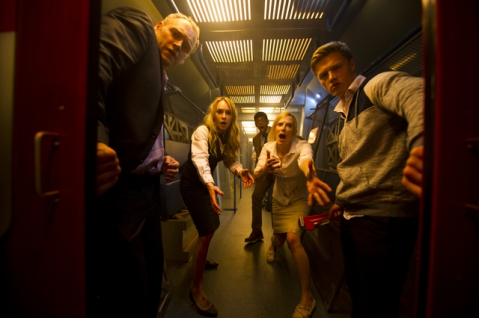 This is one of the most conventional horror films around in recent years, a straight to DVD film about people being eaten by werewolves on a train. These films have always been the bottom of the pile for the horror genre, but it recent years especially there has been a huge surge in the amount of moderate budget horror created. Most of which doesn’t make it to cinemas and is lucky if it gets a spot-on television. But out of this vast abyss of corny horror films, Howl managed to scrape a 70% on Rotten Tomatoes, miles ahead of most of ‘these’ film types.
This is one of the most conventional horror films around in recent years, a straight to DVD film about people being eaten by werewolves on a train. These films have always been the bottom of the pile for the horror genre, but it recent years especially there has been a huge surge in the amount of moderate budget horror created. Most of which doesn’t make it to cinemas and is lucky if it gets a spot-on television. But out of this vast abyss of corny horror films, Howl managed to scrape a 70% on Rotten Tomatoes, miles ahead of most of ‘these’ film types.
First off, as with these generic horror films, they are extremely predictable and Howl is no exception. You can guess the people which will die early on within seconds of them being on screen. The biggest reveal this film has to offer is the surprise that there is more than one werewolf. Also, these films rarely have imagination to the direction, with the age-old point of view shots from the creature’s looking at the victims through the woods. Howl fits with this as well, with Hyett (Howl being his most famous picture) using his fair share of the troops. The acting as well will be often, terrible, Howl manages to maintain a mostly acceptable level across the board. And the writing could have been done by anyone, with characters making the poorest decisions and character archetypes of the genre being used fully. But surprisingly Howl manages to be an entertaining film, as when a film fits these conventions like a glove to a well-executed standard, and has enough budget in the special effects department, it can be irresistible.
The horror genre is one of the most successful genre at creating bad films, which make a good time. The film’s enjoyment can be mirrored by the style behind of special effects. When you finally see the beast, it is so over the top and borderline laughable, that you simply suspend all rational thoughts other than to just be entertained by the carnage. There is something extremely entertaining about a film which executes this style with fair levels of skill, harking back to the genre’s early years such as Friday the 13th. Films which knew that the sole pleasure that they offered was the thrills, chills and laughs and watching one character at a time being gruesomely dismembered. This is exactly what is offered by Howl, and the only aspect that makes it work is plenty of action and predictability and solid special effects department. The reveal scene of the first werewolf in all its glory comes unfortunately late in the film, but as you can see when you google the film, is such an odd spectacle that it’s just enjoyable.
It’s very easy to be critical of films like this, and any criticism that are made could be just as easy applied to any straight to DVD horror film that came out in the last 10 years. The only unique criticism that could be thrown at Howl is that the werewolves, don’t look like wolves. But this film can serve as a great guilty pleasure film, if the mood is right you can relish the violence and the cliché nature of the film type. So, Howl manages to separate itself from ‘the rest’ by the following. All the clichés are meet, which would usually be a drag but when they are done in such a (overall) visually well executed manor, with a great batch of monster to boot it offers great fun. Most likely the film isn’t worth by many people’s standards the price stage of the Blue-ray copy, but it’s a good bonus as well.
Verdict : Have fun in watching an classic style of horror film executed just as badly as all the rest. But with a lot of blood and hilarious monsters it’s a fun guilty pleasure.
Verdict : 3/5
Quote : “Bear’s don’t Howl”
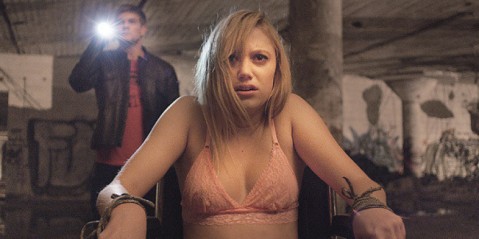 2014 was a big year for modern horror, with three standouts gaining big critical (although not box office) success. Those being, A Girl Walks Home Alone at Night, It Follows and The Babadook. It is rare, given the amount that fly under the radar, for a horror film to be praised by critics, and each of these films was for very different reasons. It Follows got noticed for both its indie vibe as well as its retro feel and setting, with homage paid to both the set design of the classic 1970’s slasher horror film as well as the style of filming. Directed and written by David Robert Mitchell (a filmmaker famous for little else) made a unique film, not only for the reasons listed, but also for the ‘monster’ of the film as well as the imagery that is used.
2014 was a big year for modern horror, with three standouts gaining big critical (although not box office) success. Those being, A Girl Walks Home Alone at Night, It Follows and The Babadook. It is rare, given the amount that fly under the radar, for a horror film to be praised by critics, and each of these films was for very different reasons. It Follows got noticed for both its indie vibe as well as its retro feel and setting, with homage paid to both the set design of the classic 1970’s slasher horror film as well as the style of filming. Directed and written by David Robert Mitchell (a filmmaker famous for little else) made a unique film, not only for the reasons listed, but also for the ‘monster’ of the film as well as the imagery that is used.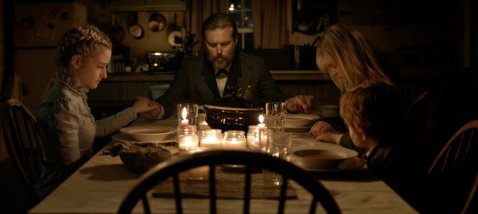 We Are What We Are became noticed via its appearance at the Cannes Film Festival in 2013, it was up for a minor directorial nomination. The film was since meet with across the board positive critical success. Director Jim Mickle has gone on to have similar small film critical success with the equally dark and violent thriller Cold In July (2014). The film’s most abstract plot is that of a family with a cannibalistic ritual living in a secluded American town. The advertisement campaign didn’t boast this feature too much, and rightly so, as to label the film a straight out cannibal horror would be wrong.
We Are What We Are became noticed via its appearance at the Cannes Film Festival in 2013, it was up for a minor directorial nomination. The film was since meet with across the board positive critical success. Director Jim Mickle has gone on to have similar small film critical success with the equally dark and violent thriller Cold In July (2014). The film’s most abstract plot is that of a family with a cannibalistic ritual living in a secluded American town. The advertisement campaign didn’t boast this feature too much, and rightly so, as to label the film a straight out cannibal horror would be wrong.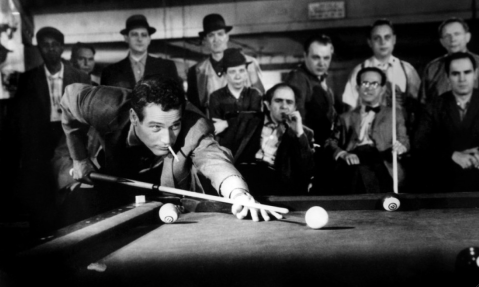
Recent Comments